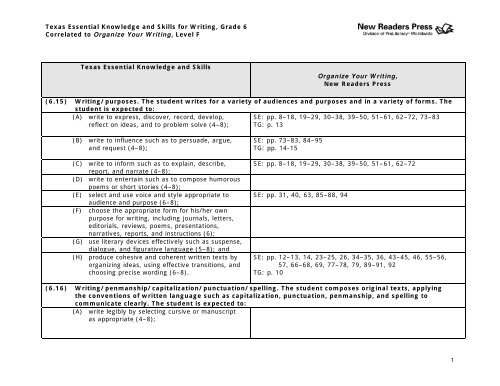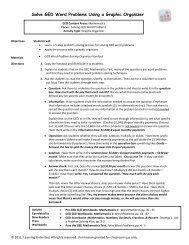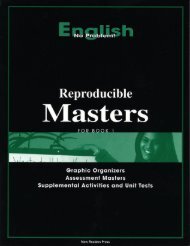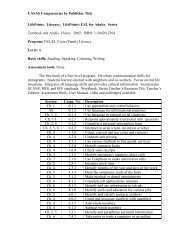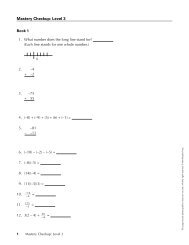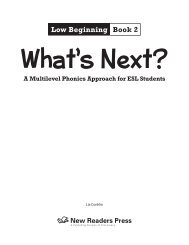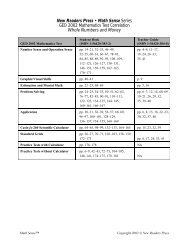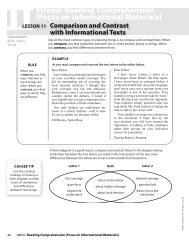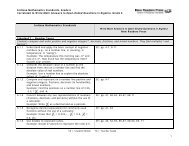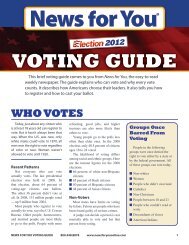TEKS Correlation - New Readers Press
TEKS Correlation - New Readers Press
TEKS Correlation - New Readers Press
You also want an ePaper? Increase the reach of your titles
YUMPU automatically turns print PDFs into web optimized ePapers that Google loves.
Texas Essential Knowledge and Skills for Writing, Grade 6<br />
Correlated to Organize Your Writing, Level F<br />
Texas Essential Knowledge and Skills<br />
Organize Your Writing,<br />
<strong>New</strong> <strong>Readers</strong> <strong>Press</strong><br />
(6.15) Writing/purposes. The student writes for a variety of audiences and purposes and in a variety of forms. The<br />
student is expected to:<br />
(A) write to express, discover, record, develop,<br />
reflect on ideas, and to problem solve (4–8);<br />
SE: pp. 8–18, 19–29, 30–38, 39–50, 51–61, 62–72, 73–83<br />
TG: p. 13<br />
(B)<br />
(C)<br />
(D)<br />
(E)<br />
(F)<br />
(G)<br />
(H)<br />
write to influence such as to persuade, argue,<br />
and request (4–8);<br />
write to inform such as to explain, describe,<br />
report, and narrate (4–8);<br />
write to entertain such as to compose humorous<br />
poems or short stories (4–8);<br />
select and use voice and style appropriate to<br />
audience and purpose (6–8);<br />
choose the appropriate form for his/her own<br />
purpose for writing, including journals, letters,<br />
editorials, reviews, poems, presentations,<br />
narratives, reports, and instructions (6);<br />
use literary devices effectively such as suspense,<br />
dialogue, and figurative language (5–8); and<br />
produce cohesive and coherent written texts by<br />
organizing ideas, using effective transitions, and<br />
choosing precise wording (6–8).<br />
SE: pp. 73–83, 84–95<br />
TG: pp. 14-15<br />
SE: pp. 8–18, 19–29, 30–38, 39–50, 51–61, 62–72<br />
SE: pp. 31, 40, 63, 85–88, 94<br />
SE: pp. 12–13, 14, 23–25, 26, 34–35, 36, 43–45, 46, 55–56,<br />
57, 66–68, 69, 77–78, 79, 89–91, 92<br />
TG: p. 10<br />
(6.16) Writing/penmanship/capitalization/punctuation/spelling. The student composes original texts, applying<br />
the conventions of written language such as capitalization, punctuation, penmanship, and spelling to<br />
communicate clearly. The student is expected to:<br />
(A) write legibly by selecting cursive or manuscript<br />
as appropriate (4–8);<br />
1
Texas Essential Knowledge and Skills for Writing, Grade 6<br />
Correlated to Organize Your Writing, Level F<br />
Texas Essential Knowledge and Skills<br />
Organize Your Writing,<br />
<strong>New</strong> <strong>Readers</strong> <strong>Press</strong><br />
(B) capitalize and punctuate correctly to clarify and<br />
enhance meaning such as capitalizing titles,<br />
using hyphens, semicolons, colons, possessives,<br />
and sentence punctuation (6–8);<br />
(C) write with accurate spelling of syllable<br />
constructions, including closed, open, consonant<br />
before –le, and syllable boundary patterns (3–6);<br />
(D) write with accurate spelling of roots such as<br />
drink, speak, read, or happy, inflections such as<br />
those that change tense or number, suffixes such<br />
as –able or –less, and prefixes such as re- or un-<br />
(4–6);<br />
(E) use resources to find correct spellings (4–8);<br />
(F) spell accurately in final drafts (4–8); and<br />
(G) understand the influence of other languages and<br />
cultures on the spelling of English words (6–8).<br />
(6.17) Writing/grammar/usage. The student applies standard grammar and usage to communicate clearly and<br />
effectively in writing. The student is expected to:<br />
(A) use regular and irregular plurals correctly (4–6);<br />
(B) write in complete sentences, varying the types<br />
such as compound and complex, and use of<br />
appropriately punctuated dependent clauses (6);<br />
(C) use conjunctions to connect ideas meaningfully SE: p. 57<br />
(4–8);<br />
(D) use adjectives (comparative and superlative TG p. 12<br />
forms) and adverbs appropriately to make<br />
writing vivid or precise (4–8);<br />
(E) use prepositional phrases to elaborate written<br />
ideas (4–8);<br />
2
Texas Essential Knowledge and Skills for Writing, Grade 6<br />
Correlated to Organize Your Writing, Level F<br />
Texas Essential Knowledge and Skills<br />
Organize Your Writing,<br />
<strong>New</strong> <strong>Readers</strong> <strong>Press</strong><br />
(F) employ standard English usage in writing for<br />
audiences, including subject-verb agreement,<br />
pronoun referents, and parts of speech (4–8);<br />
(G) use verb tenses appropriately and consistently<br />
such as present, past, future, perfect, and<br />
progressive (6–8);<br />
(H) write with increasing accuracy when using<br />
apostrophes in contractions such as doesn’t and<br />
possessives such as Maria’s (4–8); and<br />
(I) write with increasing accuracy when using<br />
pronoun case such as “He and they joined him.”<br />
(6–8).<br />
(6.18) Writing/writing process. The student selects and uses writing processes for self-initiated and assigned<br />
writing. The student is expected to:<br />
(A)<br />
generate ideas and plans for writing by using<br />
prewriting strategies such as brainstorming,<br />
graphic organizers, notes, and logs (4–8);<br />
SE: pp. 6, 10-11, 21-23, 32-33, 41-42, 53-54, 64-65, 75-76,<br />
86-88<br />
TG; p. 6<br />
(B)<br />
(C)<br />
(D)<br />
(E)<br />
develop drafts by categorizing ideas, organizing<br />
them into paragraphs, and blending paragraphs<br />
within larger units of text (4–8);<br />
revise selected drafts by adding, elaborating,<br />
deleting, combining, and rearranging text (4–8);<br />
revise drafts for coherence, progression, and<br />
logical support of ideas (4–8);<br />
edit drafts for specific purposes such as to<br />
ensure standard usage, varied sentence<br />
structure, and appropriate word choice (4–8);<br />
SE: pp. 11–13, 23–25, 33–35, 42–45, 54–56, 66–68, 77–78,<br />
89–91<br />
TG: pp. 7, 8, 11, 12<br />
SE: pp. 16–17, 27–28, 37, 48–49, 59–60, 70–71, 81–82, 93–94<br />
SE: pp. 16–17, 27–28, 37, 48–49, 59–60, 70–71, 81–82, 93–94<br />
SE: pp. 28, 37, 60, 71<br />
TG: p. 12<br />
3
Texas Essential Knowledge and Skills for Writing, Grade 6<br />
Correlated to Organize Your Writing, Level F<br />
Texas Essential Knowledge and Skills<br />
Organize Your Writing,<br />
<strong>New</strong> <strong>Readers</strong> <strong>Press</strong><br />
(F) use available technology to support aspects of SE: pp. 18, 29, 38, 50, 63, 72, 83, 95<br />
creating, revising, editing, and publishing texts<br />
(4–8);<br />
(G) refine selected pieces frequently to “publish” for<br />
general and specific audiences (4–8);<br />
(H) proofread his/her own writing and that of others TG: p. 15<br />
(4–8); and<br />
(I) select and use reference materials and resources<br />
as needed for writing, revising, and editing final<br />
drafts (4–8).<br />
(6.19) Writing/evaluation. The student evaluates his/her own writing and the writings of others. The student is<br />
expected to:<br />
(A) apply criteria to evaluate writing (4–8); SE: pp. 7, 13, 25, 35, 45, 56, 67, 78<br />
(B)<br />
(C)<br />
respond in constructive ways to others’ writings<br />
(4–8);<br />
evaluate how well his/her own writing achieves<br />
its purposes (4–8);<br />
SE: pp. 18, 29, 38, 50, 61, 70–72, 81–83, 93–95<br />
TG: pp. 6, 7, 8, 9, 10, 11-12, 13, 14, 15<br />
(D) analyze published examples as models for<br />
SE: pp. 17, 27, 37, 59, 64, 70–71, 81–82<br />
writing (4–8); and<br />
(E) review a collection of written works to determine<br />
its strengths and weaknesses and to set goals as<br />
a writer (4–8).<br />
(6.20) Writing/inquiry/research. The student uses writing as a tool for learning and research. The student is<br />
expected to:<br />
(A) frame questions to direct research (4–8);<br />
(B) organize prior knowledge about a topic in a<br />
variety of ways such as by producing a graphic<br />
organizer (4–8);<br />
SE: pp. 12, 22, 33–34, 43–44, 53, 55, 66, 77, 87, 89<br />
4
Texas Essential Knowledge and Skills for Writing, Grade 6<br />
Correlated to Organize Your Writing, Level F<br />
Texas Essential Knowledge and Skills<br />
Organize Your Writing,<br />
<strong>New</strong> <strong>Readers</strong> <strong>Press</strong><br />
(C) take notes from relevant and authoritative<br />
sources such as guest speakers, periodicals, and<br />
on-line searches (4–8);<br />
(D) summarize and organize ideas gained from<br />
multiple sources in useful ways such as outlines,<br />
conceptual maps, learning logs, and timelines<br />
(4–8);<br />
(E) present information in various forms using<br />
available technology (4–8);<br />
(F) evaluate his/her own research and raise new<br />
questions for further investigation (4–8); and<br />
(G) follow accepted formats for writing research,<br />
including documenting sources (6–8).<br />
(6.21) Writing/connections. The student interacts with writers inside and outside the classroom in ways that<br />
reflect the practical uses of writing. The student is expected to:<br />
(A) collaborate with other writers to compose,<br />
organize, and revise various types of texts,<br />
including letters, news, records, and forms<br />
(4–8); and<br />
(B) correspond with peers or others via e-mail or<br />
conventional mail (4–8).<br />
5
Texas Essential Knowledge and Skills for Writing, Grade 7<br />
Correlated to Organize Your Writing, Level G<br />
Texas Essential Knowledge and Skills<br />
Organize Your Writing,<br />
<strong>New</strong> <strong>Readers</strong> <strong>Press</strong><br />
(7.15) Writing/purposes. The student writes for a variety of audiences and purposes and in a variety of forms.<br />
The student is expected to:<br />
(A) write to express, discover, record, develop,<br />
reflect on ideas, and to problem solve (4–8);<br />
SE: pp. 8–18, 19–29, 30–39, 40–52, 53–63, 64–73, 74–83<br />
TG: pp. 6, 7<br />
(B)<br />
(C)<br />
(D)<br />
(E)<br />
write to influence such as to persuade, argue,<br />
and request (4–8);<br />
write to inform such as to explain, describe,<br />
report, and narrate (4–8);<br />
write to entertain such as to compose humorous<br />
poems or short stories (4–8);<br />
select and use voice and style appropriate to<br />
audience and purpose (6–8);<br />
SE: pp. 74–83, 84–95<br />
TG: pp. 14–15<br />
SE: pp. 8–18, 19–29, 30–39, 40–52, 53–63, 64–73<br />
SE: pp. 64–73<br />
TG: pp. 12–13<br />
SE: pp. 74, 76, 85–86, 91, 94<br />
TG: p. 14<br />
(F)<br />
(G)<br />
(H)<br />
choose the appropriate form for his/her own<br />
purpose for writing such as journals, letters,<br />
editorials, reviews, poems, memoirs, narratives,<br />
and instructions (7–8);<br />
use literary devices effectively such as suspense,<br />
dialogue, and figurative language (5–8); and<br />
produce cohesive and coherent written texts by<br />
organizing ideas, using effective transitions, and<br />
choosing precise wording (6–8).<br />
SE: pp. 9, 12, 17, 30–31, 33, 35, 38<br />
SE: pp. 9, 13, 15, 23–24, 26, 35, 37, 45–46, 48, 57, 59, 68,<br />
70, 78, 80, 89, 92<br />
(7.16) Writing/penmanship/capitalization/punctuation/spelling. The student composes original texts, applying<br />
the conventions of written language such as capitalization, punctuation, handwriting, penmanship, and<br />
spelling to communicate clearly. The student is expected to:<br />
(A) write legibly by selecting cursive or manuscript<br />
as appropriate (4–8);<br />
SE = Student Edition TG = Teacher’s Guide<br />
1
Texas Essential Knowledge and Skills for Writing, Grade 7<br />
Correlated to Organize Your Writing, Level G<br />
Texas Essential Knowledge and Skills<br />
Organize Your Writing,<br />
<strong>New</strong> <strong>Readers</strong> <strong>Press</strong><br />
(B) capitalize and punctuate correctly to clarify and<br />
enhance meaning such as capitalizing titles,<br />
using hyphens, semicolons, colons, possessives,<br />
and sentence punctuation (6–8);<br />
(C) spell derivatives correctly by applying the<br />
spellings of bases and affixes (7–8);<br />
(D) spell frequently misspelled words correctly such<br />
as their, they’re, and there (7–8);<br />
(E) use resources to find correct spellings (4–8);<br />
(F) spell accurately in final drafts (4–8); and<br />
(G) understand the influence of other languages and<br />
cultures on the spelling of English words (6–8).<br />
(7.17) Writing/grammar/usage. The student applies standard grammar and usage to communicate clearly and<br />
effectively in writing. The student is expected to:<br />
(A) write in complete sentences, varying the types<br />
such as compound and complex sentences, and<br />
use appropriately punctuated independent and<br />
dependent clauses (7–8);<br />
(B) use conjunctions to connect ideas meaningfully SE: p. 59<br />
(4–8);<br />
(C) employ standard English usage in writing for SE: pp. 9, 12, 17<br />
audiences, including subject-verb agreement,<br />
pronoun referents, and parts of speech (4–8);<br />
(D) use adjectives (comparative and superlative SE: pp. 9, 12, 17<br />
forms) and adverbs appropriately to make<br />
writing vivid or precise (4–8);<br />
(E) use prepositional phrases to elaborate written<br />
ideas (4–8);<br />
(F) use verb tenses appropriately and consistently<br />
such as present, past, future, perfect, and<br />
progressive (6–8);<br />
SE = Student Edition TG = Teacher’s Guide<br />
2
Texas Essential Knowledge and Skills for Writing, Grade 7<br />
Correlated to Organize Your Writing, Level G<br />
Texas Essential Knowledge and Skills<br />
Organize Your Writing,<br />
<strong>New</strong> <strong>Readers</strong> <strong>Press</strong><br />
(G) write with increasing accuracy when using<br />
apostrophes in contractions such as won’t and<br />
possessives such as Smith’s (4–8); and<br />
(H) write with increasing accuracy when using<br />
pronoun case such as “She had the party.”<br />
(6–8).<br />
(7.18) Writing/writing processes. The student selects and uses writing processes for self-initiated and assigned<br />
writing. The student is expected to:<br />
(A)<br />
(B)<br />
generate ideas and plans for writing by using<br />
prewriting strategies such as brainstorming,<br />
graphic organizers, notes, and logs (4–8);<br />
develop drafts by categorizing ideas, organizing<br />
them into paragraphs, and blending paragraphs<br />
within larger units of text (4–8);<br />
SE: pp. 6, 10, 32, 33, 35, 42–43, 55, 67, 77, 87–88<br />
TG: pp. 6, 10<br />
SE: pp. 14–16, 25–26, 36–37, 47–49, 58–60, 69–71, 79–80,<br />
90–92<br />
TG: pp. 8, 9, 11<br />
(C)<br />
(D)<br />
(E)<br />
(F)<br />
(G)<br />
(H)<br />
revise selected drafts by adding, elaborating,<br />
deleting, combining, and rearranging text (4–8);<br />
revise drafts for coherence, progression, and<br />
logical support of ideas (4–8);<br />
edit drafts for specific purposes such as to<br />
ensure standard usage, varied sentence<br />
structure, and appropriate word choice (4–8);<br />
use available technology to support aspects of<br />
creating, revising, editing, and publishing texts<br />
(4–8);<br />
refine selected pieces frequently to “publish” for<br />
general and specific audiences (4–8);<br />
proofread his/her own writing and that of others<br />
(4–8); and<br />
SE: pp. 17, 27–28, 38, 50–51, 61–62, 72, 81–82, 93–94<br />
SE: pp. 17, 27–28, 50–51, 62, 72, 82, 94<br />
TG: p. 10<br />
SE: pp. 17, 38, 62, 82<br />
SE: pp. 18, 29, 39, 52, 63, 73, 83, 95<br />
SE = Student Edition TG = Teacher’s Guide<br />
3
Texas Essential Knowledge and Skills for Writing, Grade 7<br />
Correlated to Organize Your Writing, Level G<br />
Texas Essential Knowledge and Skills<br />
Organize Your Writing,<br />
<strong>New</strong> <strong>Readers</strong> <strong>Press</strong><br />
(I) select and use reference materials and resources<br />
as needed for writing, revising, and editing final<br />
drafts (4–8).<br />
(7.19) Writing/evaluation. The student evaluates his/her own writing and the writings of others. The student is<br />
expected to:<br />
(A) apply criteria to evaluate writing (4–8); SE: pp. 7, 14, 25, 36, 47, 58, 69, 79, 91<br />
(B)<br />
(C)<br />
respond in constructive ways to others’ writings<br />
(4–8);<br />
evaluate how well his/her own writing achieves<br />
its purposes (4–8);<br />
SE: pp. 18, 29, 39, 52, 63, 73, 83, 95<br />
TG: pp. 7, 8, 9, 10, 12, 13, 14, 15<br />
(D) analyze published examples as models for<br />
SE: pp. 27, 38, 50, 61, 72, 81, 94<br />
writing (4–8); and<br />
(E) review a collection of written works to determine<br />
its strengths and weaknesses and to set goals as<br />
a writer (4–8).<br />
(7.20) Writing/inquiry/research. The student uses writing as a tool for learning and research. The student is<br />
expected to:<br />
(A) frame questions to direct research (4–8);<br />
(B) organize prior knowledge about a topic in a<br />
variety of ways such as by producing a graphic<br />
SE: pp. 13, 24, 35, 46, 57, 68, 89<br />
TG: pp. 11, 13<br />
organizer (4–8);<br />
(C) take notes from relevant and authoritative<br />
sources such as guest speakers, periodicals, and<br />
on-line searches (4–8);<br />
(D) summarize and organize ideas gained from<br />
multiple sources in useful ways such as outlines,<br />
conceptual maps, learning logs, and timelines<br />
(4–8);<br />
SE: pp. 19–29<br />
SE = Student Edition TG = Teacher’s Guide<br />
4
Texas Essential Knowledge and Skills for Writing, Grade 7<br />
Correlated to Organize Your Writing, Level G<br />
Texas Essential Knowledge and Skills<br />
Organize Your Writing,<br />
<strong>New</strong> <strong>Readers</strong> <strong>Press</strong><br />
(E) present information in various forms using<br />
available technology (4–8);<br />
(F) evaluate his/her own research and frame new<br />
questions for further investigation (4–8); and<br />
(G) follow accepted formats for writing research,<br />
including documenting sources (6–8).<br />
(7.21) Writing/connections. The student interacts with writers inside and outside the classroom in ways that<br />
reflect the practical uses of writing. The student is expected to:<br />
(A) collaborate with other writers to compose,<br />
organize, and revise various types of texts,<br />
including letters, news, records, and forms<br />
(4–8);<br />
(B) correspond with peers or others via e-mail or<br />
conventional mail (4–8); and<br />
(C) identify challenges faced by published authors<br />
and strategies they use to compose various<br />
types of text (7–8).<br />
SE = Student Edition TG = Teacher’s Guide<br />
5
Texas Essential Knowledge and Skills for Writing, Grade 8<br />
Correlated to Organize Your Writing, Level H<br />
Texas Essential Knowledge and Skills<br />
Organize Your Writing,<br />
<strong>New</strong> <strong>Readers</strong> <strong>Press</strong><br />
(8.15) Writing/purposes. The student writes for a variety of audiences and purposes and in a variety of forms.<br />
The student is expected to:<br />
(A) write to express, discover, record, develop,<br />
reflect on ideas, and to problem solve (4–8);<br />
SE: pp. 8–18, 19–30, 31–40, 41–52, 53–62, 74–84, 85–95<br />
TG: pp. 7–8<br />
(B)<br />
(C)<br />
(D)<br />
(E)<br />
(F)<br />
(G)<br />
(H)<br />
write to influence such as to persuade, argue,<br />
and request (4–8);<br />
write to inform such as to explain, describe,<br />
report, and narrate (4–8);<br />
write to entertain such as to compose humorous<br />
poems or short stories (4–8);<br />
select and use voice and style appropriate to<br />
audience and purpose (6–8);<br />
choose the appropriate form for his/her own<br />
purpose for writing such as journals, letters,<br />
editorials, reviews, poems, memoirs, memoirs,<br />
narratives, and instructions (7–8);<br />
use literary devices effectively such as suspense,<br />
dialogue, and figurative language (5–8); and<br />
produce cohesive and coherent written texts by<br />
organizing ideas, using effective transitions, and<br />
choosing precise wording (6–8).<br />
SE: pp. 74–84, 85–95<br />
TG: pp. 14–15, 15–16<br />
SE: pp. 8–18, 19–30, 31–40, 41–52, 53–62, 63–73<br />
TG: pp. 6–7, 9–10, 11–12, 13–14<br />
SE: pp. 63–73<br />
TG: pp. 13–14<br />
SE: pp. 75, 77, 85–95<br />
TG: pp. 15–16<br />
SE: pp. 31–32<br />
SE: pp. 8–9, 13, 15, 17, 24–25, 27, 31–32, 36, 37, 39, 41,<br />
45–46, 48, 51, 53, 57, 59, 61, 63, 67, 69, 79, 81, 85,<br />
89, 92<br />
TG: p. 7<br />
SE = Student Edition TG = Teacher’s Guide<br />
1
Texas Essential Knowledge and Skills for Writing, Grade 8<br />
Correlated to Organize Your Writing, Level H<br />
Texas Essential Knowledge and Skills<br />
Organize Your Writing,<br />
<strong>New</strong> <strong>Readers</strong> <strong>Press</strong><br />
(8.16) Writing/penmanship/capitalization/punctuation/spelling. The student composes original texts, applying<br />
the conventions of written language such as capitalization, punctuation, penmanship, and spelling to<br />
communicate clearly. The student is expected to:<br />
(A) write legibly by selecting cursive or manuscript<br />
as appropriate (4–8);<br />
(B) capitalize and punctuate correctly to clarify and<br />
enhance meaning such as capitalizing titles,<br />
using hyphens, semicolons, colons, possessives,<br />
and sentence punctuation (6–8);<br />
(C) spell derivatives correctly by applying the<br />
spellings of bases and affixes (7–8);<br />
(D) spell frequently misspelled words correctly such<br />
as their, they’re, and there (7–8);<br />
(E) use resources to find correct spellings (4–8);<br />
(F) spell accurately in final drafts (4–8); and<br />
(G) understand the influence of other languages and<br />
cultures on the spelling of English words (6–8);<br />
(8.17) Writing/grammar/usage. The student applies standard grammar and usage to communicate clearly and<br />
effectively in writing. The student is expected to:<br />
(A) write in complete sentences, varying the types<br />
such as compound and complex sentences, and<br />
use appropriately punctuated independent and<br />
dependent clauses (7–8);<br />
(B) use conjunctions to connect ideas meaningfully SE: p. 59<br />
(4–8);<br />
(C) employ standard English usage in writing for<br />
audiences, including subject-verb agreement,<br />
pronoun referents, and parts of speech (4–8);<br />
SE = Student Edition TG = Teacher’s Guide<br />
2
Texas Essential Knowledge and Skills for Writing, Grade 8<br />
Correlated to Organize Your Writing, Level H<br />
Texas Essential Knowledge and Skills<br />
Organize Your Writing,<br />
<strong>New</strong> <strong>Readers</strong> <strong>Press</strong><br />
(D) use adjectives (comparative and superlative SE: pp. 8–9, 13, 17<br />
forms) and adverbs appropriately to make<br />
writing vivid or precise (4–8);<br />
(E) use prepositional phrases to elaborate written<br />
ideas (4–8);<br />
(F) use verb tenses appropriately and consistently<br />
such as present, past, future, perfect, and<br />
progressive (6–8);<br />
(G) write with increasing accuracy when using<br />
apostrophes in contractions such as doesn’t and<br />
possessives such as Texas’s (4–8); and<br />
(H) write with increasing accuracy when using<br />
pronoun case such as “She stepped between<br />
them and us.” (6–8).<br />
(8.18) Writing/writing processes. The student selects and uses writing processes for self-initiated and assigned<br />
writing. The student is expected to:<br />
(A)<br />
(B)<br />
(C)<br />
(D)<br />
(E)<br />
generate ideas and plans for writing by using<br />
prewriting strategies such as brainstorming,<br />
graphic organizers, notes, and logs (4–8);<br />
develop drafts by categorizing ideas, organizing<br />
them into paragraphs, and blending paragraphs<br />
within larger units of text (4–8);<br />
revise selected drafts by adding, elaborating,<br />
deleting, combining, and rearranging text (4–8);<br />
revise drafts for coherence, progression, and<br />
logical support of ideas (4–8);<br />
edit drafts for specific purposes such as to<br />
ensure standard usage, varied sentence<br />
structure, and appropriate word choice (4–8);<br />
SE: pp. 6, 10, 23, 33, 35, 44, 55, 66, 77, 78, 88<br />
TG: pp. 7, 11, 14, 15<br />
SE: pp. 14–16, 26–27, 37–38, 47–49, 58–59, 68–70, 80–81,<br />
90–92<br />
SE: pp. 17, 28–29, 39, 50–51, 60–61, 71–72, 82–83, 93–94<br />
SE: pp. 17, 28–29, 51, 61, 72, 83, 94<br />
SE: pp. 17, 39, 51, 61, 72, 83<br />
SE = Student Edition TG = Teacher’s Guide<br />
3
Texas Essential Knowledge and Skills for Writing, Grade 8<br />
Correlated to Organize Your Writing, Level H<br />
Texas Essential Knowledge and Skills<br />
Organize Your Writing,<br />
<strong>New</strong> <strong>Readers</strong> <strong>Press</strong><br />
(F) use available technology to support aspects of SE: pp. 18, 30, 40, 52, 62, 73, 84, 95<br />
creating, revising, editing, and publishing texts<br />
(4–8);<br />
(G) refine selected pieces frequently to “publish” for<br />
general and specific audiences (4–8);<br />
(H) proofread his/her own writing and that of others<br />
(4–8); and<br />
(I) select and use reference materials and resources<br />
as needed for writing, revising, and editing final<br />
drafts (4–8).<br />
(8.19) Writing/evaluation. The student evaluates his/her own writing and the writings of others. The student is<br />
expected to:<br />
(A) apply criteria to evaluate writing (4–8); SE: pp. 7, 14, 26, 37, 47, 58, 68, 80, 90<br />
(B)<br />
(C)<br />
respond in constructive ways to others’ writings<br />
(4–8);<br />
evaluate how well his/her own writing achieves<br />
its purposes (4–8);<br />
TG: p. 13<br />
SE: pp. 18, 30, 40, 52, 62, 73, 84, 95<br />
TG: pp. 7, 8, 9, 10, 12, 14, 16<br />
(D) analyze published examples as models for<br />
SE: pp. 17, 28, 39, 50–51, 60, 71–72, 82–83<br />
writing (4–8); and<br />
(E) review a collection of written works to determine<br />
its strengths and weaknesses and to set goals as<br />
a writer (4–8).<br />
(8.20) Writing/inquiry/research. The student uses writing as a tool for learning and research. The student is<br />
expected to:<br />
(A) frame questions to direct research (4–8);<br />
(B) organize prior knowledge about a topic in a<br />
variety of ways such as by producing a graphic<br />
organizer (4–8);<br />
SE: pp. 13, 25, 36, 46, 57, 67, 78, 89<br />
SE = Student Edition TG = Teacher’s Guide<br />
4
Texas Essential Knowledge and Skills for Writing, Grade 8<br />
Correlated to Organize Your Writing, Level H<br />
Texas Essential Knowledge and Skills<br />
Organize Your Writing,<br />
<strong>New</strong> <strong>Readers</strong> <strong>Press</strong><br />
(C) take notes from relevant and authoritative<br />
sources such as guest speakers, periodicals, and<br />
on-line searches (4–8);<br />
(D) summarize and organize ideas gained from<br />
multiple sources in useful ways such as outlines,<br />
conceptual maps, learning logs, and timelines<br />
(4–8);<br />
(E) present information in various forms using<br />
available technology (4–8);<br />
(F) evaluate his/her own research and frame new<br />
questions for further investigation (4–8); and<br />
(G) follow accepted formats for writing research,<br />
including documenting sources (6–8).<br />
(8.21) Writing/connections. The student interacts with writers inside and outside the classroom in ways that<br />
reflect the practical uses of writing. The student is expected to:<br />
(A) collaborate with other writers to compose,<br />
organize, and revise various types of texts,<br />
including letters, news, records, and forms<br />
(4–8);<br />
(B) correspond with peers or others via e-mail or<br />
conventional mail (4–8); and<br />
(C) identify challenges faced by published authors<br />
and strategies they use to compose various<br />
types of text (7–8).<br />
SE = Student Edition TG = Teacher’s Guide<br />
5
Texas Essential Knowledge and Skills for Writing, Grade 9<br />
Correlated to Organize Your Writing, Level I<br />
Texas Essential Knowledge and Skills<br />
Organize Your Writing,<br />
<strong>New</strong> <strong>Readers</strong> <strong>Press</strong><br />
(9.1) Writing/purposes. The student writes in a variety of forms, including business, personal, literary, and<br />
persuasive texts, for various audiences and purposes. The student is expected to:<br />
(A) write in a variety of forms using effective word<br />
choice, structure, and sentence forms with<br />
emphasis on organizing logical arguments with<br />
clearly related definitions, theses, and evidence;<br />
write persuasively; write to report and describe;<br />
and write poems, plays, and stories;<br />
SE: pp. 8–18, 19–29, 30–40, 41–53, 54–63, 64–73, 74–84,<br />
85–95<br />
TG: pp. 6–7, 7–9, 9–10, 10–12, 12–13, 13–14, 14–15, 15–16<br />
(B)<br />
write in a voice and style appropriate to audience<br />
and purpose; and<br />
SE: pp. 74–84, 85–95<br />
TG: pp. 14–15, 15–16<br />
(C)<br />
organize ideas in writing to ensure coherence,<br />
logical progression, and support for ideas.<br />
SE: pp. 8, 13, 19, 23–24, 30, 35, 41, 46–47, 54, 58, 64, 68,<br />
79, 85, 89<br />
TG: pp. 8, 13, 14<br />
(9.2) Writing/writing processes. The student uses recursive writing processes when appropriate. The student is<br />
expected to:<br />
(A) use prewriting strategies to generate ideas,<br />
develop voice, and plan;<br />
SE: pp. 10–13, 21–24, 32–35, 43–47, 56–58, 66–68, 76–79,<br />
87–90<br />
TG: p. 15<br />
(B)<br />
(C)<br />
(D)<br />
develop drafts, alone and collaboratively, by<br />
organizing and reorganizing content and by<br />
refining style to suit occasion, audience, and<br />
purpose;<br />
proofread writing for appropriateness of<br />
organization, content, style, and conventions;<br />
refine selected pieces frequently to publish for<br />
general and specific audiences; and<br />
SE: pp. 14–16, 25–26, 36–37, 48–49, 59–60, 69–70, 80–81,<br />
91–92<br />
SE: pp. 17, 27–28, 38–39, 51–52, 61–62, 71–72, 83–84,<br />
93–94<br />
SE = Student Edition TG = Teacher’s Guide<br />
1
Texas Essential Knowledge and Skills for Writing, Grade 9<br />
Correlated to Organize Your Writing, Level I<br />
Texas Essential Knowledge and Skills<br />
Organize Your Writing,<br />
<strong>New</strong> <strong>Readers</strong> <strong>Press</strong><br />
(E)<br />
use technology for aspects of creating, revising,<br />
editing, and publishing.<br />
SE: pp. 30–40<br />
TG: pp. 9–10<br />
(9.3) Writing/grammar/usage/conventions/spelling. The student relies increasingly on the conventions and<br />
mechanics of written English, including the rules of grammar and usage, to write clearly and effectively.<br />
The student is expected to:<br />
(A) produce legible work that shows accurate<br />
spelling and correct use of the conventions of<br />
punctuation and capitalization such as italics and<br />
ellipses;<br />
(B) demonstrate control over grammatical elements<br />
such as subject-verb agreement, pronounantecedent<br />
agreement, verb forms, and<br />
parallelism;<br />
(C) compose increasingly more involved sentences<br />
that contain gerunds, participles, and infinitives<br />
in their various functions; and<br />
(D) produce error-free writing in the final draft.<br />
(9.4) Writing/inquiry/research. The student uses writing as a tool for learning. The student is expected to:<br />
(A) use writing to formulate questions, refine topics,<br />
and clarify ideas;<br />
(B) use writing to discover, organize, and support<br />
what is known and what needs to be learned<br />
about a topic;<br />
(C) compile information from primary and secondary<br />
sources in systematic ways using available<br />
technology;<br />
(D)<br />
represent information in a variety of ways such<br />
as graphics, conceptual maps, and learning logs;<br />
SE: pp. 47, 56<br />
TG: p. 12<br />
SE = Student Edition TG = Teacher’s Guide<br />
2
Texas Essential Knowledge and Skills for Writing, Grade 9<br />
Correlated to Organize Your Writing, Level I<br />
Texas Essential Knowledge and Skills<br />
Organize Your Writing,<br />
<strong>New</strong> <strong>Readers</strong> <strong>Press</strong><br />
(E)<br />
use writing as a study tool to clarify and<br />
remember information;<br />
SE: pp. 19–29<br />
TG: pp. 7–9<br />
(F)<br />
(G)<br />
compile written ideas and representations into<br />
reports, summaries, or other formats and draw<br />
conclusions; and<br />
analyze strategies that writers in different fields<br />
use to compose.<br />
SE: pp. 19–29<br />
TG: pp. 7–9<br />
(9.5) Writing/evaluation. The student evaluates his/her own writing and the writings of others. The student is<br />
expected to:<br />
(A) evaluate writing for both mechanics and content;<br />
and<br />
SE: pp. 7, 18, 29, 40, 53, 63, 73, 84, 95<br />
TG: pp. 7, 9, 10, 11, 13, 14, 15, 16<br />
(B)<br />
respond productively to peer review of his/her<br />
own work.<br />
SE = Student Edition TG = Teacher’s Guide<br />
3
Texas Essential Knowledge and Skills for Writing, Grade 10<br />
Correlated to Organize Your Writing, Level J<br />
Texas Essential Knowledge and Skills<br />
Organize Your Writing,<br />
<strong>New</strong> <strong>Readers</strong> <strong>Press</strong><br />
(10.1) Writing/purposes. The student writes in a variety of forms, including business, personal, literary, and<br />
persuasive texts, for various audiences and purposes. The student is expected to:<br />
(A) write in a variety of forms with an emphasis on<br />
persuasive forms such as logical argument and<br />
expression of opinion, personal forms such as<br />
response to literature, reflective essay, and<br />
autobiographical narrative, and literary forms<br />
such as poems, plays, and stories;<br />
SE: pp. 8–18, 19–29, 30–40, 41–53, 54–63, 64–73, 74–84,<br />
85–95<br />
TG: pp. 6–7, 7–8, 8–10, 10–11, 11–12, 13–14, 14–15, 15–16<br />
(B)<br />
write in a voice and a style appropriate to<br />
audience and purpose; and<br />
SE: pp. 74–84, 85–95<br />
TG: pp. 14–15, 15–16<br />
(C)<br />
organize ideas in writing to ensure coherence,<br />
logical progression, and support for ideas.<br />
SE: pp. 8, 12, 19, 23–24, 30, 35, 41, 46–47, 54, 59, 64, 68,<br />
74, 79, 85, 90<br />
TG: pp. 6, 8, 9, 13, 15, 16<br />
(10.2) Writing/writing processes. The student uses recursive writing processes when appropriate. The student is<br />
expected to:<br />
(A) use prewriting strategies to generate ideas,<br />
develop voice and plan;<br />
SE: pp. 10–12, 21–24, 32–35, 43–47, 57–59, 66–68, 76–79,<br />
87–90<br />
TG: p. 16<br />
(B)<br />
(C)<br />
(D)<br />
develop drafts both alone and collaboratively by<br />
organizing and reorganizing content and by<br />
refining style to suit occasion, audience, and<br />
purpose;<br />
proofread writing for appropriateness of<br />
organization, content, style, and conventions;<br />
refine selected pieces frequently to publish for<br />
general and specific audiences; and<br />
SE: pp. 13–15, 25–26, 36–37, 48–50, 60–61, 69–70, 80–81,<br />
91–93<br />
SE: pp. 16–17, 27–28, 38–39, 51–52, 62, 71–72, 82–83, 94<br />
SE = Student Edition TG = Teacher’s Guide<br />
1
Texas Essential Knowledge and Skills for Writing, Grade 10<br />
Correlated to Organize Your Writing, Level J<br />
Texas Essential Knowledge and Skills<br />
Organize Your Writing,<br />
<strong>New</strong> <strong>Readers</strong> <strong>Press</strong><br />
(E)<br />
use technology for aspects of creating, revising,<br />
editing, and publishing texts.<br />
SE: pp. 30–40<br />
TG: pp. 8–10<br />
(10.3) Writing/grammar/usage/conventions/spelling. The student relies increasingly on the conventions and<br />
mechanics of written English, including the rules of usage and grammar, to write clearly and effectively.<br />
The student is expected to:<br />
(A) produce legible work that shows accurate<br />
spelling and correct use of the conventions of<br />
punctuation and capitalization such as italics and<br />
ellipses;<br />
(B) demonstrate control over grammatical elements<br />
such as subject-verb agreement, pronounantecedent<br />
agreement, verb forms, and<br />
parallelism;<br />
(C) compose increasingly more involved sentences<br />
that contain gerunds, participles, and infinitives<br />
in their various functions; and<br />
(D) produce error-free writing in the final draft.<br />
(10.4) Writing/inquiry/research. The student uses writing as a tool for learning. The student is expected to:<br />
(A) use writing to formulate questions, refine topics,<br />
and clarify ideas;<br />
(B) use writing to discover, organize, and support<br />
what is known and what needs to be learned<br />
about a topic;<br />
(C) compile information from primary and secondary<br />
sources in systematic ways using available<br />
technology;<br />
(D)<br />
represent information in a variety of ways such<br />
as graphics, conceptual maps, and learning logs;<br />
SE: pp. 47, 57<br />
TG: p. 12<br />
SE = Student Edition TG = Teacher’s Guide<br />
2
Texas Essential Knowledge and Skills for Writing, Grade 10<br />
Correlated to Organize Your Writing, Level J<br />
Texas Essential Knowledge and Skills<br />
Organize Your Writing,<br />
<strong>New</strong> <strong>Readers</strong> <strong>Press</strong><br />
(E)<br />
use writing as a study tool to clarify and<br />
remember information;<br />
SE: pp. 19–29<br />
TG: pp. 7–8<br />
(F)<br />
(G)<br />
compile written ideas and representations into<br />
reports, summaries, or other formats and draw<br />
conclusions; and<br />
analyze strategies that writers in different fields<br />
use to compose.<br />
SE: pp. 19–29<br />
TG: pp. 7–8<br />
(10.5) Writing/evaluation. The student evaluates his/her own writing and the writings of others. The student is<br />
expected to:<br />
(A) evaluate writing for both mechanics and content;<br />
and<br />
SE: pp. 7, 18, 29, 40, 53, 63, 73, 84, 95<br />
TG: pp. 7, 8, 9, 11, 12, 14, 15, 16<br />
(B)<br />
respond productively to peer review of his/her<br />
own work.<br />
SE = Student Edition TG = Teacher’s Guide<br />
3


